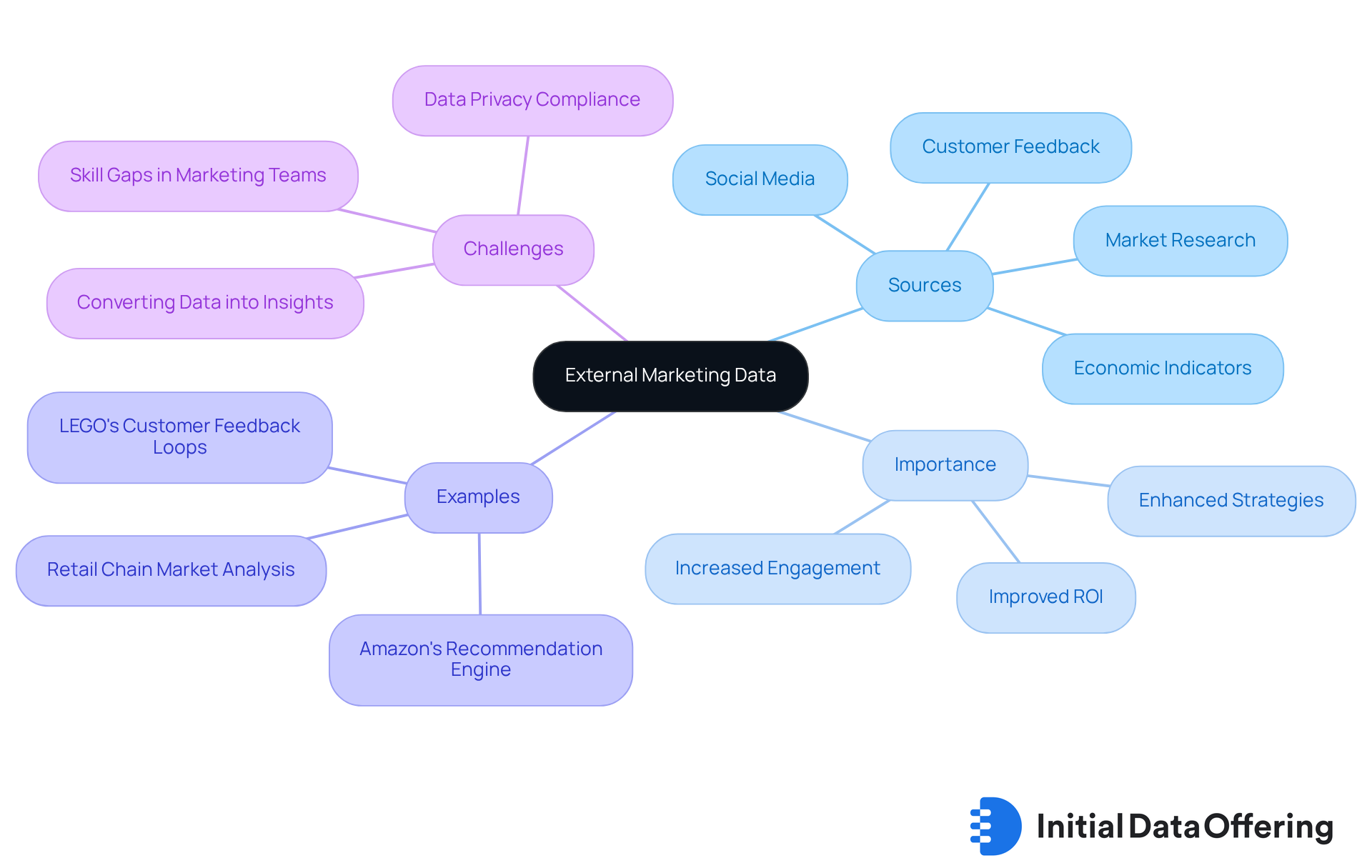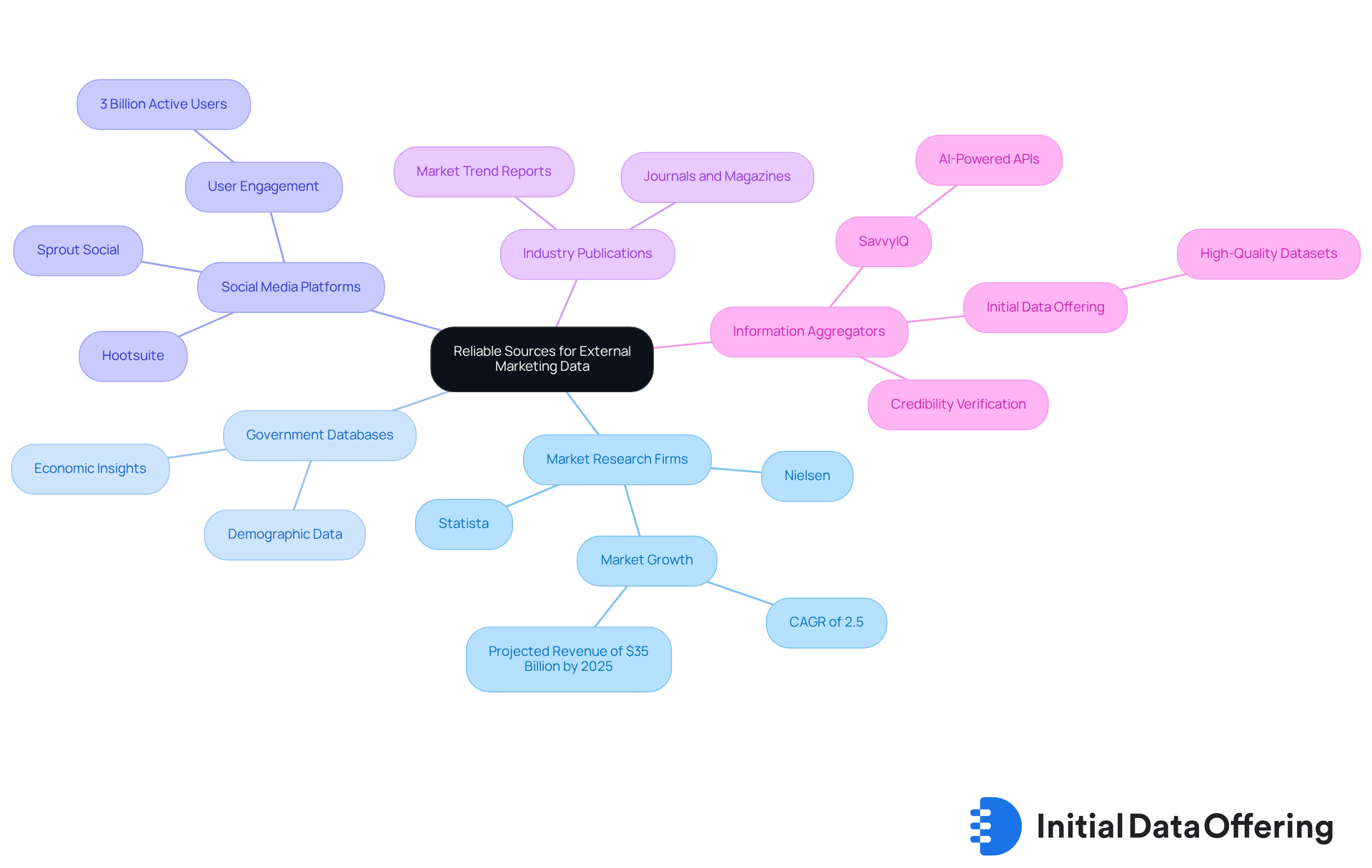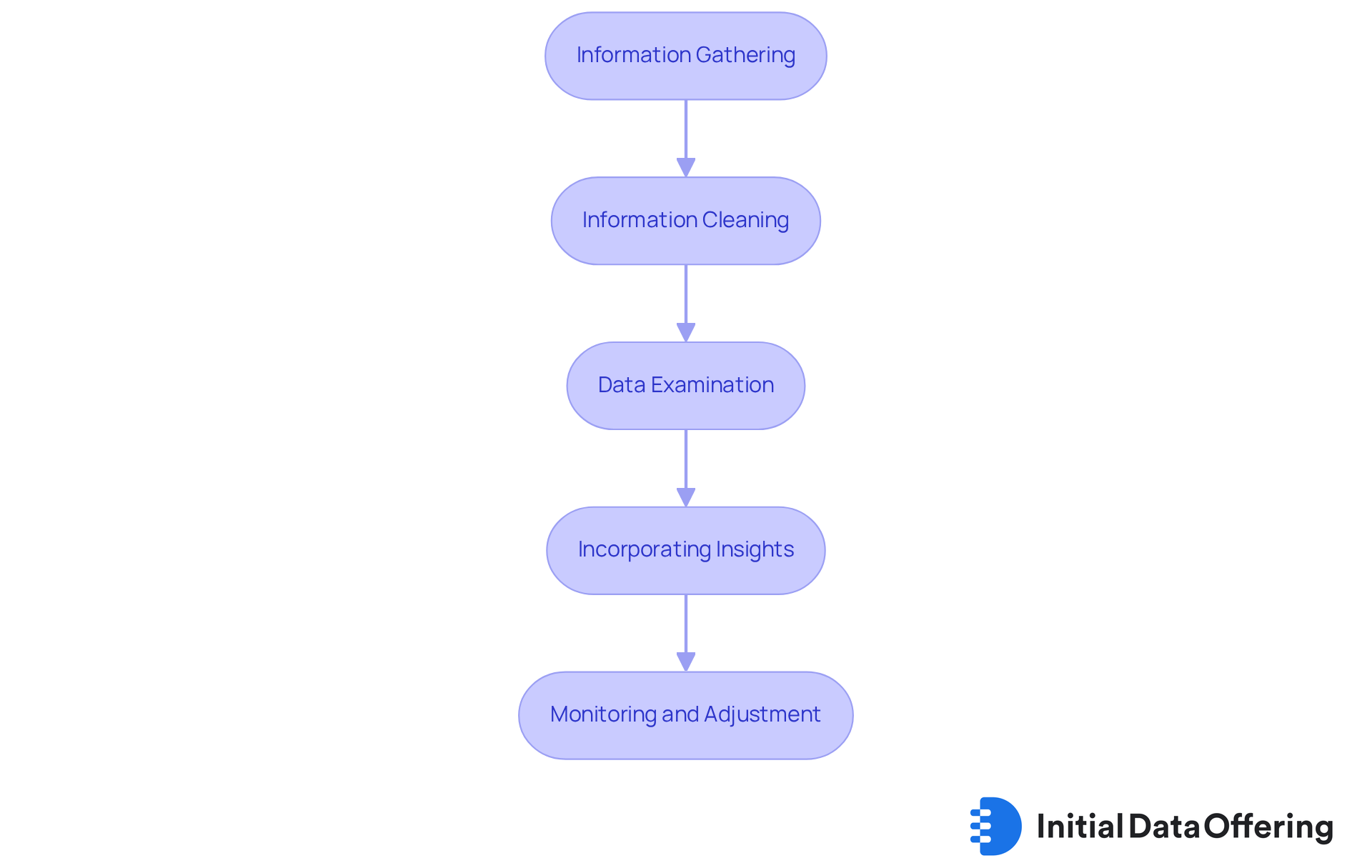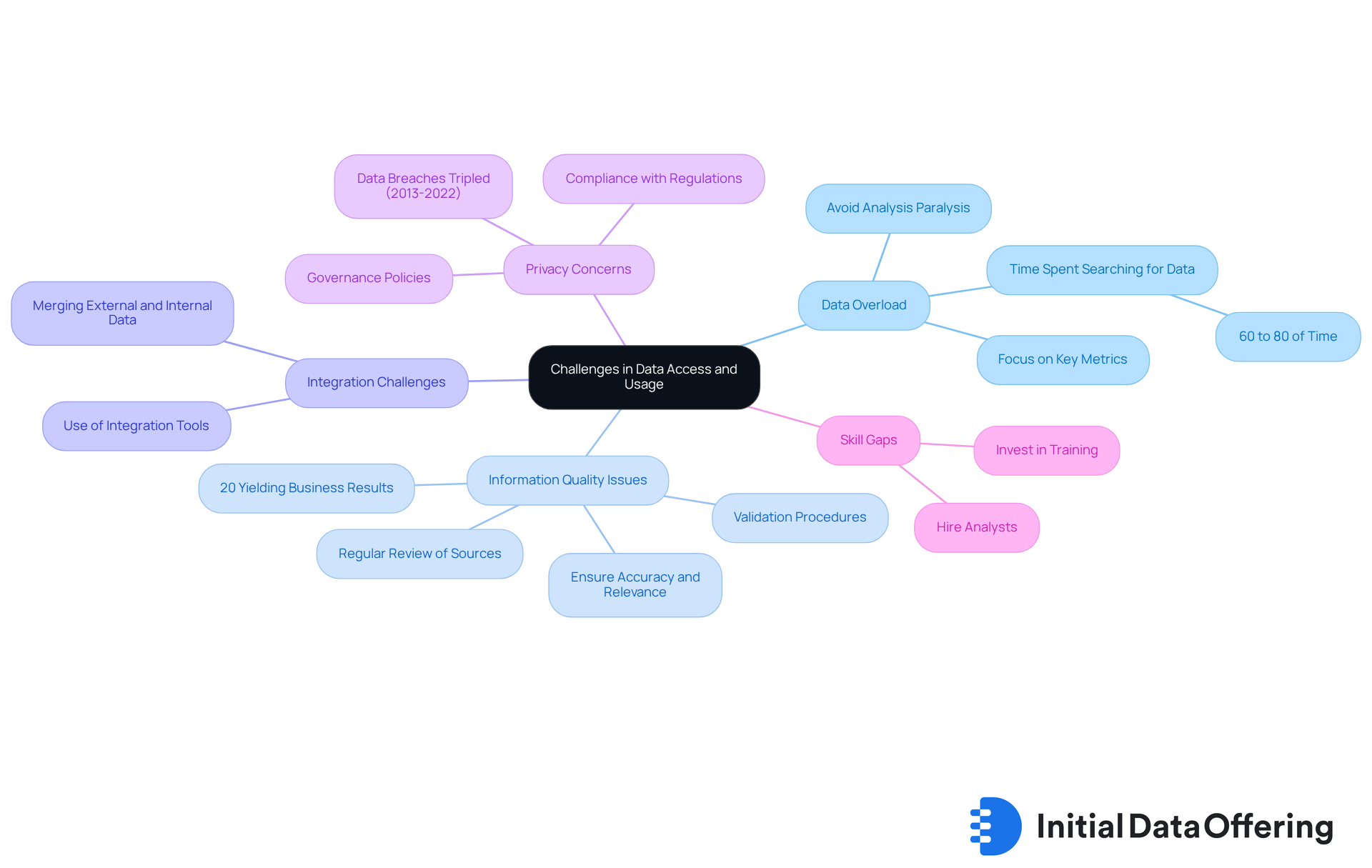How Businesses Can Retrieve External Marketing Data Effectively

How Businesses Can Retrieve External Marketing Data Effectively
Overview
Businesses can effectively retrieve external marketing data by prioritizing reliable sources such as:
- Market research firms
- Government databases
- Social media platforms
Implementing structured processes for data gathering, cleaning, and analysis is crucial. By leveraging high-quality external data, companies not only enhance their strategic decision-making but also achieve tangible improvements in marketing performance. This is evident in the success stories of companies that have integrated such insights into their promotional strategies.
How can your organization harness these insights to refine its marketing approach and drive results?
Introduction
Understanding the landscape of external marketing data is crucial for businesses aiming to thrive in a competitive environment. This type of data, sourced from customer feedback, social media interactions, and market research, serves as a feature that provides invaluable insights. The advantages of leveraging this data include:
- The ability to shape marketing strategies
- Enhance customer engagement effectively
However, the real benefit lies in the challenge of transforming this wealth of information into actionable insights that drive decision-making.
How can businesses navigate the complexities of data retrieval and utilization to unlock the full potential of external marketing data?
Understand External Marketing Data and Its Importance
External promotional information encompasses details acquired from outside an organization, including customer feedback, social media interactions, market research reports, and economic indicators. This information is vital for businesses because it highlights how businesses can retrieve external marketing data by accessing insights into market dynamics, consumer preferences, and competitive benchmarks. By effectively utilizing external information, businesses can retrieve external marketing data by accessing it to enhance their marketing strategies, increase customer engagement, and ultimately drive sales. For example, a regional retail chain analyzed market conditions of successful shops with similar economic and demographic characteristics to identify promising markets for growth. This illustrates how businesses can retrieve external marketing data by accessing it to inform their strategic choices.
Furthermore, businesses can retrieve external marketing data by accessing social media sentiment analysis to evaluate brand perception, while economic indicators can guide pricing strategies and market entry plans. Organizations that embrace analytics-based marketing approaches have observed a 20% increase in ROI compared to those relying solely on conventional methods. This highlights the transformative impact on performance when businesses can retrieve external marketing data by accessing relevant information. However, many brands encounter challenges in converting information into actionable insights for more impactful, research-driven decisions, though businesses can retrieve external marketing data by accessing various resources. As Jason Larson, Vice President of Marketing at IIA, notes, 'The incorporation of outside information is improving predictive modeling and decision-making processes in companies globally.' This underscores the importance of not only utilizing external information but also associated with its integration.

Identify Reliable Sources for External Marketing Data
To effectively obtain external marketing information, businesses should prioritize reputable sources that provide dependable and actionable insights. Key sources include:
- Market Research Firms: Organizations such as Nielsen and Statista are renowned for delivering comprehensive reports and insights across various industries. In 2025, the market research sector is expected to expand at a compound annual growth rate of 2.5%, attaining roughly $35 billion. This highlights the importance of these companies in delivering essential information for strategic decision-making.
- Government Databases: Publicly accessible information from government agencies can provide valuable economic and demographic insights. These insights are essential for informed decision-making, allowing businesses to align their strategies with broader economic trends.
- Social Media Platforms: Tools like Hootsuite and Sprout Social facilitate the analysis of customer sentiment and engagement metrics. With more than 3 billion active users on messaging applications worldwide, utilizing is essential for comprehending market dynamics and gauging public perception effectively.
- Industry Publications: Journals and magazines frequently publish studies and reports that illuminate market trends. These publications offer insights that can guide strategic planning and help organizations stay ahead of industry shifts.
- Information Aggregators: Platforms like SavvyIQ and Initial Information Offering compile insights from multiple sources to provide a holistic view of the market landscape. SavvyIQ utilizes AI-powered APIs for commercial identity and intelligence, while Initial Data Offering serves as a hub for high-quality datasets. However, it is crucial to confirm the credibility of these sources to ensure the trustworthiness of the information.
By concentrating on these trustworthy sources, including advanced solutions such as those provided by Initial Data Offering, organizations can improve their market intelligence. This, in turn, enables them to make data-informed choices that promote growth and innovation.

Access and Utilize External Marketing Data Effectively
To effectively access and utilize external marketing data, businesses should follow these essential steps:
- Information Gathering: Begin by utilizing tools and platforms to collect information from trustworthy sources. For instance, APIs from social media platforms can be employed to extract engagement metrics, providing valuable insights into consumer behavior. This step is crucial for establishing a solid foundation for data-driven decisions.
- Information Cleaning: Ensuring the precision of the information is paramount. Implement rigorous cleaning processes that involve eliminating duplicates, rectifying inconsistencies, and verifying data against reliable benchmarks. Efficient information cleaning greatly enhances the dependability of insights obtained. According to external sources, maintaining high information quality is essential, as low-quality data can lead to flawed decisions.
- Data Examination: Utilize analytical tools such as Excel, Tableau, or specialized software to evaluate the refined information. This analysis should focus on recognizing trends, patterns, and actionable insights that can guide promotional strategies. Companies that incorporate external information into their analysis have reported improvements in operational efficiency, with some realizing savings of up to $1.5 million. How could similar insights transform your strategies?
- Incorporating Insights: Integrate the insights obtained from external information into promotional strategies. Adjust advertising approaches based on consumer sentiment analysis derived from social media engagement metrics. Companies like Adobe have effectively enhanced their offerings by aligning product features with external insights, resulting in a 25% increase in subscriptions. This example illustrates the tangible benefits of leveraging external information in promotional strategies.
- Monitoring and Adjustment: Continuously observe the effectiveness of strategies informed by external information. Regularly assess performance metrics and make necessary adjustments to optimize results. This iterative process ensures that promotional strategies remain responsive to changing consumer preferences and market dynamics. Significantly, 87% of marketers indicate that information is their organization’s most under-utilized resource, underscoring the necessity of continuous assessment of analytics-based strategies.
By adhering to these steps, companies can harness the influence of external promotional information to facilitate informed decision-making and enhance their overall promotional efficiency.

Troubleshoot Common Challenges in Data Access and Usage
Businesses can retrieve external marketing data by accessing it, although they often encounter various challenges in utilizing this information. Understanding these challenges and their solutions can significantly .
- Data Overload: The sheer volume of available data can be overwhelming. By focusing on key metrics that align with business objectives, organizations can avoid analysis paralysis. Statistics indicate that organizations spend 60% to 80% of their time searching for information, underlining the need to address these challenges effectively. As Dan Vesset observes, "People spend 60% to 80% of their time attempting to locate information." This represents a substantial productivity loss that must be mitigated.
- Information Quality Issues: It is crucial to ensure that the information gathered is both accurate and relevant. Regularly reviewing information sources and applying validation procedures can help maintain quality. Notably, only 20% of analytical insights are expected to yield business results through 2022, emphasizing the critical nature of high-quality information.
- Integration Challenges: Merging external information with internal systems can be complex. To facilitate a seamless flow of information, organizations should employ integration tools and platforms designed for this purpose.
- Privacy Concerns: Organizations must remain vigilant regarding information privacy regulations and ensure compliance when collecting and utilizing external data. The rise of AI introduces unique challenges to information privacy and security, making it essential to establish robust governance policies to protect consumer data. Furthermore, information breaches have tripled between 2013 and 2022, highlighting the urgent need to address privacy issues.
- Skill Gaps: If a team lacks the necessary skills to analyze information, investing in training or hiring analysts can significantly enhance capabilities.
By proactively addressing these challenges, businesses can retrieve external marketing data by accessing its potential to drive strategic outcomes. As Clive Humby aptly states, "Data is the new oil," illustrating the value and challenges of data in today’s landscape.

Conclusion
Utilizing external marketing data is essential for businesses aiming to enhance their strategies and drive growth. By effectively accessing and analyzing insights from various sources, organizations can gain a competitive edge, improve customer engagement, and make informed decisions that align with market dynamics. The ability to retrieve and leverage this data not only informs strategic choices but also empowers businesses to adapt to evolving consumer preferences and industry trends.
Key arguments presented include the importance of identifying reliable sources such as:
- market research firms
- government databases
- social media platforms
These sources provide actionable insights. Following a structured approach to data access and utilization is necessary, encompassing:
- information gathering
- cleaning
- examination
- continuous monitoring
Addressing common challenges such as:
- data overload
- quality issues
- integration hurdles
is vital for maximizing the effectiveness of external marketing data.
In conclusion, the strategic use of external marketing data can significantly enhance business performance and decision-making processes. Organizations are encouraged to embrace analytics-driven approaches, invest in the right tools, and remain vigilant regarding data quality and privacy concerns. By doing so, they can unlock the full potential of external data, turning it into a valuable asset that drives innovation and growth in an increasingly competitive landscape.
Frequently Asked Questions
What is external marketing data?
External marketing data refers to information acquired from outside an organization, including customer feedback, social media interactions, market research reports, and economic indicators.
Why is external marketing data important for businesses?
It is important because it provides insights into market dynamics, consumer preferences, and competitive benchmarks, which can enhance marketing strategies, increase customer engagement, and drive sales.
How can businesses utilize external marketing data?
Businesses can utilize external marketing data by analyzing market conditions, evaluating brand perception through social media sentiment analysis, and using economic indicators to guide pricing strategies and market entry plans.
Can you provide an example of how a business used external marketing data?
A regional retail chain analyzed market conditions of successful shops with similar economic and demographic characteristics to identify promising markets for growth.
What impact does analytics-based marketing have on business performance?
Organizations that embrace analytics-based marketing approaches have observed a 20% increase in ROI compared to those relying solely on conventional methods.
What challenges do businesses face when using external marketing data?
Many brands encounter challenges in converting external information into actionable insights for more impactful, research-driven decisions.
What does Jason Larson say about the use of external information?
Jason Larson, Vice President of Marketing at IIA, notes that the incorporation of outside information is improving predictive modeling and decision-making processes in companies globally.